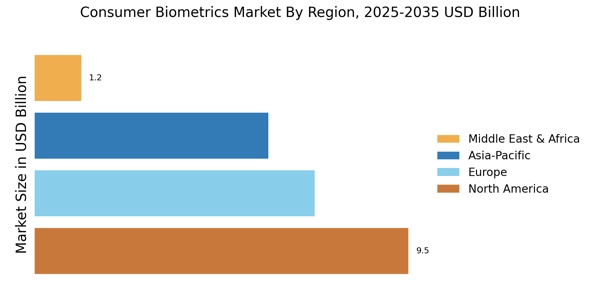Increasing Regulatory Compliance
The Consumer Biometrics Market is significantly influenced by the growing emphasis on regulatory compliance across various sectors. Governments and regulatory bodies are implementing stringent data protection laws, which necessitate the adoption of secure authentication methods. For instance, the General Data Protection Regulation (GDPR) in Europe mandates organizations to protect personal data, thereby driving the demand for biometric solutions that ensure compliance. As organizations strive to meet these regulations, the market for consumer biometrics is likely to expand, with an estimated growth rate of 20% annually. This regulatory landscape compels businesses to invest in biometric technologies, positioning them as a critical driver in the Consumer Biometrics Market.
Expansion of Smart Devices and IoT
The proliferation of smart devices and the Internet of Things (IoT) is a significant driver for the Consumer Biometrics Market. As more devices become interconnected, the need for secure authentication methods becomes paramount. Biometric technologies are increasingly being integrated into smart home devices, wearables, and personal electronics, providing users with seamless and secure access. The market for IoT devices is expected to reach 30 billion units by 2025, creating vast opportunities for biometric solutions. This integration not only enhances security but also improves user convenience, making biometrics an attractive option for consumers. The expansion of smart devices and IoT is thus a critical factor in the growth trajectory of the Consumer Biometrics Market.
Growing Adoption of Mobile Payments
The increasing adoption of mobile payment solutions is a key driver for the Consumer Biometrics Market. As consumers seek more convenient and secure payment methods, biometric authentication technologies such as fingerprint and facial recognition are becoming essential. According to recent data, the mobile payment market is projected to reach USD 12 trillion by 2025, indicating a substantial growth opportunity for biometric solutions. This trend is further fueled by the rising number of smartphone users, which is expected to surpass 6 billion by 2025. Consequently, the integration of biometrics in mobile payment systems not only enhances security but also improves user experience, making it a pivotal factor in the expansion of the Consumer Biometrics Market.
Advancements in Biometric Technology
Technological advancements play a crucial role in shaping the Consumer Biometrics Market. Innovations in biometric modalities, such as iris recognition and voice authentication, are enhancing the accuracy and reliability of biometric systems. The introduction of multimodal biometric systems, which combine various biometric traits, is also gaining traction. These advancements not only improve security but also broaden the applicability of biometrics across different sectors, including finance, healthcare, and retail. The market for biometric technology is projected to grow at a compound annual growth rate (CAGR) of 18% from 2025 to 2030, indicating a robust demand for advanced biometric solutions. This technological evolution is a significant driver for the Consumer Biometrics Market.
Rising Consumer Awareness of Privacy
Consumer awareness regarding privacy and data security is increasingly influencing the Consumer Biometrics Market. As individuals become more informed about the risks associated with data breaches and identity theft, there is a growing preference for biometric solutions that offer enhanced security. Surveys indicate that over 70% of consumers express concerns about their personal data being compromised, leading to a heightened demand for biometric authentication methods. This trend is particularly evident in sectors such as banking and e-commerce, where secure transactions are paramount. Consequently, the rising consumer awareness of privacy issues is likely to propel the growth of the Consumer Biometrics Market, as businesses seek to address these concerns through innovative biometric solutions.


















Leave a Comment